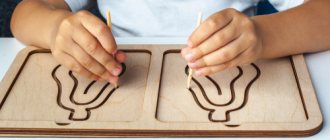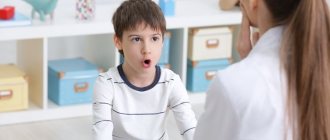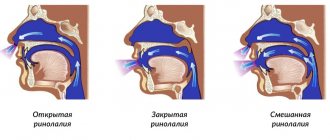Home → Information about diseases → Alalia signs, symptoms and treatment of sensory and motor alalia.
Alalia is the absence or underdevelopment of speech in children with normal hearing and primarily intact intelligence; The cause of Alalia is most often damage to the speech areas of the cerebral hemispheres during childbirth, as well as diseases of the nervous system or traumatic brain injuries suffered by the child in the pre-speech period of life. Severe degrees of Alalia are expressed in children by a complete absence of speech or the presence of babbling fragments of words; milder cases are characterized by limited vocabulary, agrammatisms, and difficulties in mastering reading and writing in the future.
Symptoms and signs of alalia.
Symptoms primarily depend on the type of alalia. Motor alalia has characteristic symptoms: poor development of hand movements; poor coordination; poor performance; speech can only appear by age 4; inability to express one's thoughts in words; replacing some words with others; incorrectly constructed sentences; reluctance to talk; touchiness, isolation, aggressiveness. Sensory alalia has characteristic symptoms: impaired speech perception; repeating words after someone; isolation; changing letters in words; merging several words into one; impulsiveness, increased activity, but at the same time the child may be withdrawn or depressed by something; lack of connection between an object and the word that denotes it.
FORMS OF ALALIA:
Pediatric neurologists and reflexotherapists distinguish 2 main forms of alalia: motor alalia, sensory alalia.
Making a diagnosis
Diagnosis of sensory-motor alalia is complicated by the dependence of the child’s behavior on the environment. In an unfamiliar place, speech disturbances may look like a complete absence of speech, even a lack of reaction to a name. Other symptoms are also distorted. Therefore, several visits are sometimes required to establish an accurate diagnosis.
The primary diagnosis may be suspected by the local physician, but three specialists are needed to accurately diagnose and develop a treatment plan. This is an otorhinolaryngologist (and sometimes an audiologist), a neurologist, a neuropsychologist and a speech therapist. They pay attention not only to the level of speech development, but also to other symptoms of sensorimotor alalia in children:
- increased impulsiveness;
- mood swings;
- acute reaction to stimuli of normal strength (sound, light);
- coordination problems;
- underdevelopment of fine motor skills;
- memory disorders;
- restlessness or lethargy;
- neurotic phenomena - stuttering, enuresis;
- sleep disorders;
- appetite disorders.
When diagnosing, first of all, hearing impairment is excluded, then autism and other mental illnesses, and mental retardation. Then they determine the type of alalia - sensory, motor or mixed. A neurologist can diagnose disorders in the functioning of the speech centers of the brain, but in order to accurately determine the specific type of disease, he needs the help of other specialists.
It is not uncommon to encounter two diseases in one patient—sensorimotor alalia with autistic features; the symptoms of these two conditions are sometimes similar, but the following problems are added to those characteristic of alalia:
- stereotypical movements,
- narrow range of interests,
- impoverished emotional sphere,
- copying the speech of others and pronounced echolalia,
- difficulties with self-care.
In such cases, it is extremely important to establish both diagnoses, determine the degree of their severity and select therapy for the child.
Motor alalia.
Motor alalia (a. motoria; lat. motor motor) is an underdevelopment of expressive speech, expressed in the difficulty of mastering an active vocabulary and grammatical structure of the language with a fairly intact understanding of speech. Motor alalia is based on a disorder or underdevelopment of the analytical-synthetic activity of the speech motor analyzer, expressed, in particular, by the replacement of subtle and complex articulatory differentiations with coarser and simpler ones.
Causes of motor alalia.
The cause of motor alalia is damage to the cortical end of the speech motor analyzer (Broca's center) and its pathways, or a decrease in the functional activity of this center.
Motor alalia develops when the functions of the fronto-parietal areas of the cortex of the left hemisphere of the brain (Broca's center) are impaired and manifests itself in a violation of expressive speech with a fairly good understanding of addressed speech, late formation of phrasal speech (after 4 years) and poverty of pre-speech stages (frequent absence of babbling) . Accompanied by a gross violation of the grammatical structure (lack of agreement of words in gender, case and number, incorrect use of prepositions, absence of verbal forms in speech, rearrangement of syllables and sounds within a word, etc.). There is a pronounced poverty of vocabulary.
Motor alalia underlies disorders of school skills such as dyslexia and dysgraphia, as well as disorders of spatial gnosis and motor disorders such as apraxia; it is combined with local and diffuse neurological symptoms and damage to the structures of the dominant hemisphere, which determines the possibilities of expressive speech. In the mental state of children with a similar disorder, there are often manifestations of varying degrees of severity of psychoorganic syndrome in the form of motor disinhibition, attention and performance disorders in combination with intellectual development disorders.
Treatment of sensorimotor alalia in children
Therapy for children diagnosed with sensorimotor alalia should be comprehensive, based on the individual characteristics of the disease in a particular child. It is also necessary to be systematic and attend classes regularly.
Treatment consists of medical, speech therapy, and psychological assistance.
The medical component of therapy consists of prescribing medications that stimulate brain metabolism and restore connections between neurons. Nootropics, multivitamins and other groups of drugs are used as needed. The course includes physiotherapeutic techniques (laser therapy, acupuncture, electrophonophoresis, electrical stimulation, magnetic therapy), massage.
Sensory alalia.
Sensory alalia (a. sensoria; lat. sensus feeling, sensation) is an underdevelopment of impressive speech, when there is a gap between the meaning and the sound envelope of words; the child’s understanding of the speech of others is impaired, despite good hearing and intact abilities to develop active speech. The cause of sensory alalia is damage to the cortical end of the auditory-speech analyzer (Wernicke's center) and its pathways.
Causes of sensory alalia.
The main cause of sensory alalia is damage to the temporal region of the left hemisphere (Wernicke's center) and is associated with disturbances in the acoustic-gnostic aspect of speech while hearing is intact. It manifests itself in insufficient understanding of addressed speech and a gross violation of its phonetic side with a lack of differentiation of sounds. In children, the correlation between an object and a word is difficult and delayed in development: they do not understand the speech of others, due to which expressive speech is extremely limited. Children distort words, mix sounds that are similar in pronunciation, do not listen to the speech of others, may not respond to calls, but at the same time react to abstract noises, echolalia is noted; auditory attention is sharply impaired, although the timbre of speech and intonation are not changed. In the mental state, there are signs of organic brain damage - often in combination with intellectual underdevelopment in a wide range (from mild partial developmental delays to mental retardation).
At the same time, this division is conditional, since in practice there are combinations of both motor Alalia and sensory and sensorimator Alalia.
Speech disorders
First of all, parents notice in their children signs of sensorimotor alalia associated with speech. This:
- misunderstanding of spoken speech, in severe forms - inability to distinguish between speech and other sounds;
- difficulty pronouncing sounds and syllables;
- illiterate construction of phrases, up to the absence of phrasal speech or gross errors;
- speech is usually at the level of babble and interjections; if there are words, then these are nouns or only their roots;
- the child can spontaneously repeat individual words several times or for a long time (echolalia), but cannot reproduce them at the request of an adult;
- The child, trying to communicate, uses mainly facial expressions and gestures.
Such violations lead to difficulties in communicating with other children in kindergarten, development groups, and on playgrounds. There are also difficulties in communicating with adults: they do not understand the child. The level of intelligence, initially normal in most cases, begins to decline without pedagogical and medical assistance.
Prognosis for recovery
If you do not receive proper rehabilitation, there may be risks of dysarthria, stuttering, neuroses, tics and other problems. Often children with the sensorimotor type of alalia experience difficulties with socialization and communication with people around them. Complete relief from sensorimotor alalia is possible only with the correct selection of treatment methods and compliance with all doctors’ requirements. After correction, mental development gradually normalizes. There is the possibility of compensation up to the development level of peers.
Sensorimotor alalia: how to recognize the problem and what to do?
Severe underdevelopment of speech, which is expressed in its complete absence or in severe and extensive disturbances in the development of speech function, may be a sign of sensorimotor alalia. From this complex word, two components can be distinguished: sensory alalia (impaired speech perception) and motor alalia (impaired motor function of the articulatory apparatus responsible for the speech sphere). The most common form of this pathology is a combined form.
The later you realize that you need to see a specialist, the stronger the manifestations of this pathology will become over time, and the chances of changing the situation will only decrease.
Symptoms of sensorimotor alalia
You need to know that often damage to the brain structures responsible for speech function occurs in the prenatal period.
It is bad if the mother had various kinds of pathological conditions that could lead to fetal hypoxia, birth trauma, or infection of the fetus and newborn. These include: threat of miscarriage, toxicosis, anemia, cardiovascular or pulmonary insufficiency, feto-placental insufficiency, low physical activity, smoking of the mother herself or her forced presence with smokers, hypertension, hypotension, various somatic diseases, frequent and prolonged ARVI, intrauterine infection of the fetus with specific infections (cytomegaly, toxoplasmosis, listeriosis, herpes, etc.).
Also, poisoning with various chemicals or overdose of drugs can cause toxic damage to the central nervous system in the unborn child.
At birth, a child may experience various conditions leading to oxygen deficiency or birth injuries: placental abruption, umbilical cord entanglement, asphyxia, rapid or rapid labor, and also, on the contrary, prolonged labor with weak labor. After birth, the baby may suffer from severe jaundice (conjugative jaundice of newborns), pneumonia, and may be on artificial ventilation for a long time.
And at an early age, when the baby’s body is very fragile and its functions have not yet formed, another misfortune may await him - meningitis, encephalitis, traumatic brain injury.
All these reasons, with general immaturity or prematurity of the child, as well as with pedagogical neglect, can have a detrimental effect on the integrity and function of brain structures.
It is very important to suspect the development of sensorimotor alalia as early as possible based on the following signs:
- general lack of coordination, awkwardness, poor understanding of the body diagram;
- poorly developed fine motor skills;
- insufficient attention, memory;
- late development of speech functions (humming, babbling, intonation, appearance of the first syllables and words);
- gross distortion of sounds or words during repetition;
- meaningless repetition of words and sounds;
- incoherent own speech;
- increased speech activity, and at the same time there is a gross violation of phonemic hearing and misunderstanding of addressed speech.
The last three positions are more likely to relate to sensory alalia.
Treatment of sensorimotor alalia in children
Many speech therapists begin working with a child only from 4, or even 5 years old. And it's just a disaster!
Classes with the baby should be carried out from birth. If you know that you have had the harmful factors described above that affect your child’s speech function, then urgently contact specialists who know how to work with young children! Otherwise, precious time will be lost, and then the treatment of alalia will be long and expensive.
So, along with physiotherapeutic methods, exercise therapy, drug treatment, osteopathy, general and speech therapy massage , it is necessary to engage in fine motor skills, the development of the articulatory apparatus, sensory development, including in a specially equipped sensory room . For sensorimotor alalia, the Tomatis Method .
The child should be periodically observed by an early development specialist and receive a set of preventive and, if necessary, corrective measures.
Our center employs highly professional specialists: speech therapists , defectologists, neuropsychologists , who are proficient in methods of restoring the psychomotor and speech development of children from birth.
If you are a caring and responsible mother, and not just a woman who gave birth to another child, then you know that it is better and easier to prevent than to treat.
Main reasons
The main causes of sensorimotor alalia:
- intrauterine infections (rubella, herpes, toxoplasmosis and others);
- hypoxia, toxicosis;
- birth injuries;
- hydrocephalus (atrophy of parts of the child’s brain);
- complications after meningitis;
- chronic diseases in the mother;
- traumatic brain injuries in early childhood.
All cases of sensorimotor alalia are accompanied by mental retardation. It is impossible to give a positive, guaranteed prognosis for complete rehabilitation of the disease - much depends on the time of treatment. If correctional work is started late, it is extremely difficult to avoid intellectual underdevelopment. In this case, training in a specialized (correctional) school will be required.
Corrective classes for child speech development
The basis for correcting speech disorders with signs of sensorimotor alalia in children is working with a speech therapist or speech pathologist. Group classes are possible, but at the initial stage it is better to study individually.
The specialist helps step by step:
- at the first stage, teaches how to correctly perceive and reproduce sounds and words;
- The second stage of therapy is aimed at constructing words and short phrases and developing dialogue skills. At the same time, the set of words in the lexicon is enriched;
- The third stage of correctional work consists of developing monologue speech and consolidating grammar.
Classes are conducted in a playful way, using toys and pictures. Usually the baby undergoes therapy on an outpatient basis. But in more complex cases, hospitalization in specialized hospitals is indicated.
It is useful to develop fine motor skills. Drawing, classes with construction sets, mosaics, modeling, and appliques are suitable for these purposes. Alternative methods include hydrotherapy (hydromassage, swimming pool, therapeutic baths), and treatment with animals (dolphin therapy, hippotherapy).
A psychologist also works with the child. Under his control, the baby learns communication skills and control of the emotional and volitional sphere.
Construction of lessons
With sensory alalia, speech therapy is aimed at training a number of reactions. It is necessary to train not only phonetic hearing itself, but also motor skills, memory, and attention. The training system should be built comprehensively.
Another point is environmental control. Any sound source has an impact on the patient, so it is important to arrange quiet modes. It is also better to reduce the number of sound stimuli for the patient so that he can better learn to isolate the necessary sounds. Reducing sound stimuli is also used during classes. The main task of speech therapy work for sensory alalia is to teach the patient to understand speech in various situations and to form competent speech independently.
Exercises can be done in the format of various games. Children love games and this will help them remember the lesson better.
Alalia correction
Treatment of alalia is exclusively comprehensive. First, you need to consult a speech therapist and a psychiatrist. Our Center practices a consultation-based initial examination. Based on the diagnostic results of the child’s current condition and the suspected causes of the speech disorder, a neurological examination may be prescribed, as well as additional diagnostic measures (blood test, EEG).
The alalia correction program includes:
- playful speech therapy sessions;
- speech therapy massage;
- logorhythmics;
- play therapy;
- individual psycho-correctional classes.





